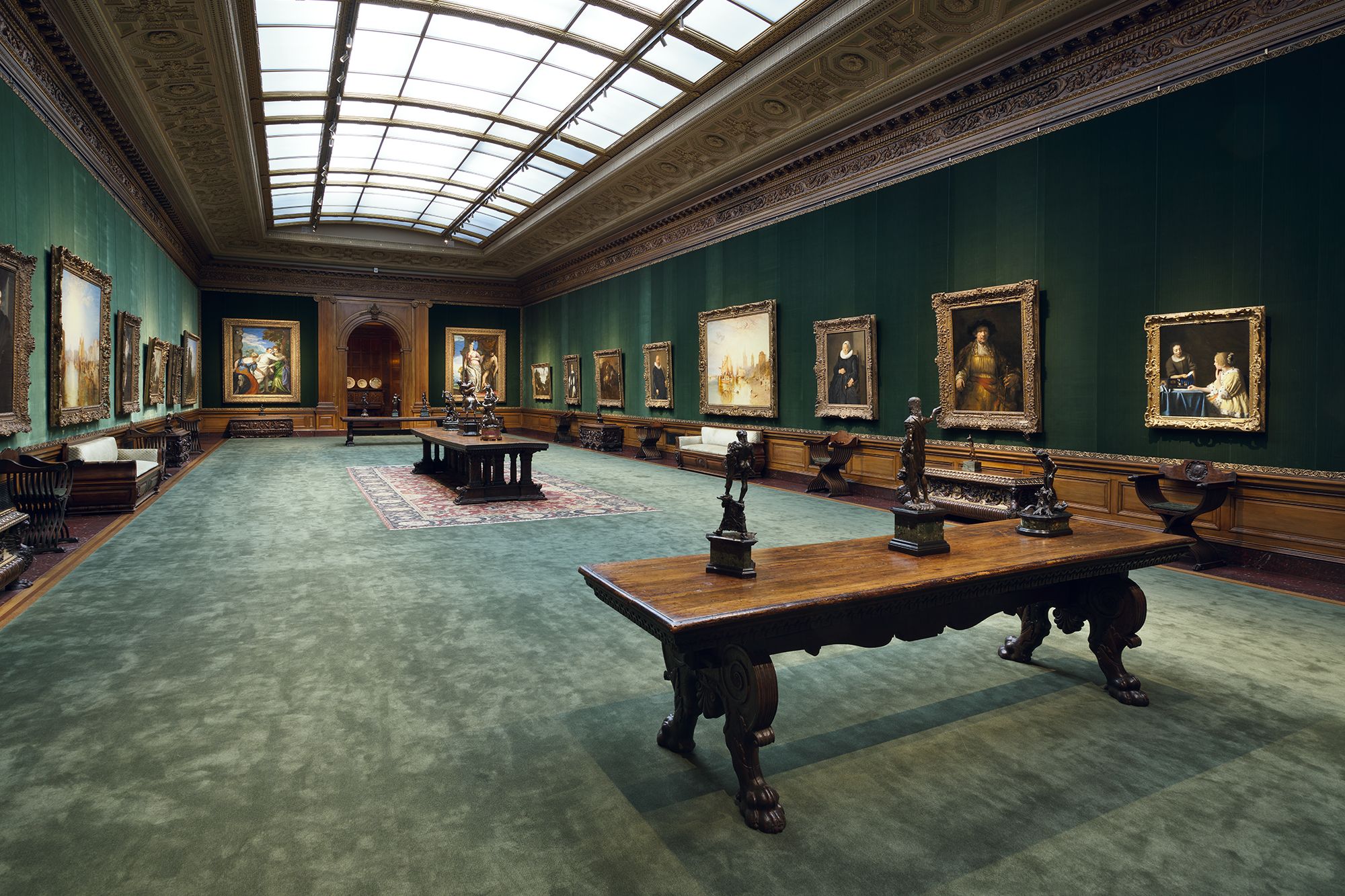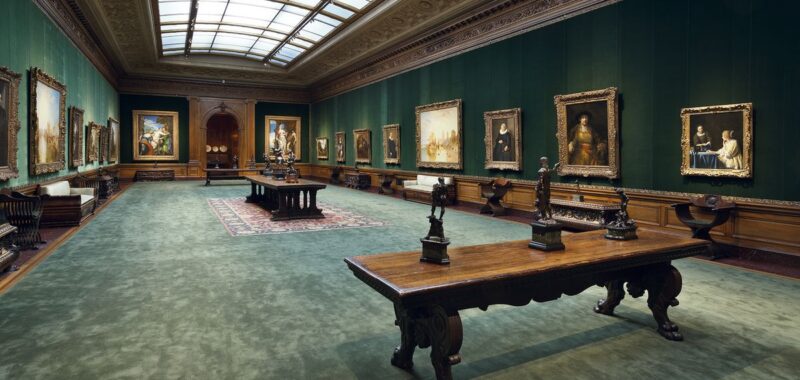
Square foot for square foot, the Frick has the densest concentration of masterpieces in America, installed alongside decorative objects in gloriously stuffy interiors. The art historian Bernard Berenson once sniffed that the Frick, founded by the morally compromised robber-baron philanthropist Henry Clay Frick, was just a “mausoleum.” Not true! Since Frick’s 1919 death, this stupendous museum has added countless gifts and acquisitions. A Watteau entered the collection in 1991. At the entrance is a wild Murillo self-portrait painted on a trompe l’oeil stone block that was added in 2014. At the Frick, we commune with the ages.
After a four-year absence for renovations, during which the collection was transported to the brutalist Breuer building on Madison Avenue, the Frick is happily back in its bigger, better Fifth Avenue manse. The cramped Music Room has been reclaimed as gallery space; the 70th Street Garden, created in 1977 by Russell Page, is intact; and although a new look-at-me staircase seems squished into the building, there is a sexy underground auditorium, a 60-seat café, and the entire second floor of the mansion is now filled with art. There’s almost twice as much on view now. What’s not to love?
Born in 1849, Henry Clay Frick is a familiar historical type: a very rich man with a great eye. Voracious and highly competitive, the industrialist moved through galleries “like a streak of lightning,” according to the wonderful new guidebook The Fricks Collect, paying record-setting prices. The collector Isabella Stewart Gardner ruefully proclaimed, “Woe is me! Why am I not Morgan or Frick?” The latter hoovered up Rembrandt’s 1655 The Polish Rider for $308,651.25 — the equivalent of over $10 million today for a work that is now worth way, way more. Frick came close to buying Holbein’s portrait Christina of Denmark, Duchess of Milan, but the National Gallery beat him to it. He turned around and bought two equally great Holbeins of Thomas More and Thomas Cromwell.
Frick preferred portraits and landscape over narrative and religious subject matter. Yet Fragonard’s magnificent The Progress of Love, installed in a beautifully restored rococo day room, is one of the great narrative cycles in this country. As for the portraits, Bellini’s supernal St. Francis in the Desert, featuring the friar receiving the stigmata upon exiting a cave into sunlight, is so marvelous it exists almost outside of time. Velázquez’s King Philip IV of Spain ranks as one of the most pathos-filled portraits ever made — or maybe that honor goes to Rembrandt’s nearby shadowy Self Portrait. Or to El Greco’s St. Jerome, who seems to be on fire, or to Bronzino’s Lodovico Capponi, a swain looking right through us as he displays an alert codpiece.
Frick secured paintings by Goya, Turner, Whistler, Veronese, Manet, and maybe too many by his faves: Van Dyck, Gainsborough, Reynolds, and George Romney. Romney’s saccharine Emma Hart, Later Lady Hamilton, As “Nature” was hung over the fireplace in his bedroom. It is likely the last painting he saw on his death bed. On the other hand, there are only 35 attributable Vermeer paintings in existence, and three (!) of them are here, including Frick’s final buy, Vermeer’s ethereal Mistress and Maid.
Following Frick’s death, his daughter, Helen Clay Frick, devoted herself to furthering the collection. The head of its Acquisitions Committee, she was the only one who could present art for the committee’s consideration. Helen fell in love with early Italian painting, and in 1927 acquired one of the most beautiful small masterpieces on earth: Duccio’s 1308-11 Temptation of Christ on the Mountain. Then she acquired the only Cimabue painting outside Europe and added Sassetta, Lippi, Veneziano, and the incomparable Piero della Francesca. In addition to one of Ingres’s greatest portraits, she obtained paintings by Bruegel and Chardin. She and her brother, Childs Frick, opened the home as a museum to the public in 1935. Since her father’s death in 1919, 55 paintings have been acquired by trustees. Today, the Frick houses over 1,800 objects.
Every visit to the Frick Collection leaves you amazed. Let’s look at a sleeper that astonished contemporaries when it was shown in London’s 1819 Royal Academy: John Constable’s The White Horse. Made when the self-taught artist was desperate for money and married with children, it is one of the most influential pictures ever painted, leading to Monet, Pissarro, and Van Gogh. (Lucian Freud observed, “I can’t see Van Gogh’s Boots without Constable behind them.”) Constable knew what he was doing, saying, “There are generally in the life of an artist perhaps one, two, or three pictures, on which hang more than usual interest — this is mine.”
At six feet wide, it is large, picturing what today is known as Constable country. In the lower-left corner, a ferry is hand-propelled by four men as a white horse, rigged with cumbersome barge-pulling gear, patiently stands aboard. They are about to cross a stream known as River Stour, in Suffolk, where Constable was born and raised. Gray rain clouds gather on the right side of the painting. A thatched, run-down boathouse sits across the river, behind which is a modest white farmhouse on the rise. (The farm is there today.) A new naturalism emerges from Constable’s jittery brushwork — daubs, dashes, and crescents of paint become a symphony of proto-Impressionism. Depth forms, but then everything rushes us back to the painted surface, returning us constantly to the whitest thing in the picture, the horse with its heavy barge tackle.
There are now works on view at the Frick that have rarely if ever been shown before: a ceiling mural that runs through two halls from 1914, a Bellini that had been hidden on the second floor, a Moroni that was acquired when the Frick was at the Breuer. The White Horse has been moved from the West Gallery to what is now the East Gallery, and it looks fantastic there. Let this painting, both luminescent and darkening around its edges, stand for the endless profundities of the Frick, where the heavy damask and dark paneled rooms surround depictions of life and light. The shadow is always encroaching, but some things are meant to endure.
See All

